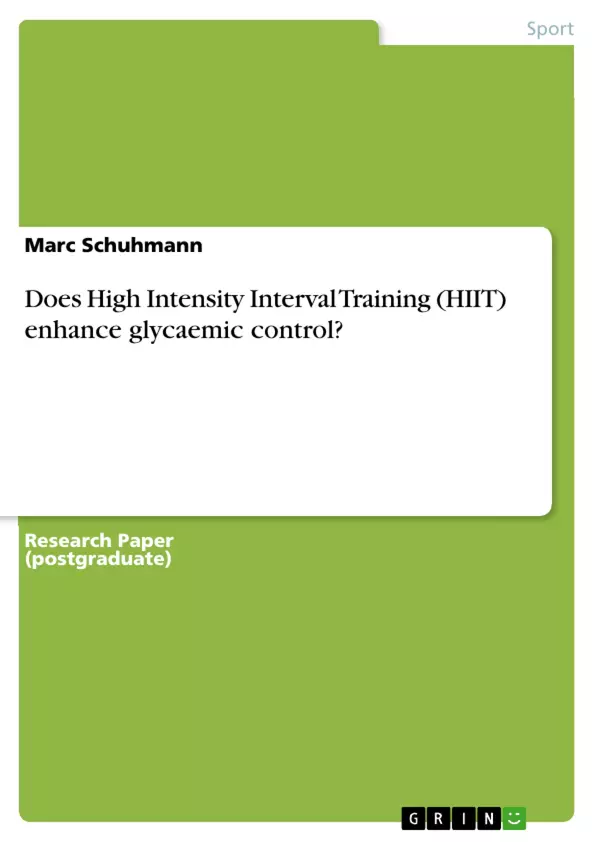High intensity interval training induces numerous morphological and metabolic adaptations in skeletal muscle. On one hand it includes mitochondrial biogenesis and therefore an enhanced capacity to oxidize fuels such as glucose and fats. This implies that a combination of anaerobic and aerobic energy systems rely on muscle glycogen and/or blood glucose as an important substrate for energy production.
On the other hand high intensity intermittent modalities improves aerobic respiratory control sensitivity resulting from increased mitochondrial density. High intensity and reduced volume of the workout utilizes type 2 muscle fibres. This muscle fiber has an anaerobic glycolytic metabolism and produces lactate by using glycogen. This results in the production of the growth hormones testosterone and somatropin. This research question plays an important role for people who are affected by type 2 diabetes or obesity which increases morbidity and mortality. Stroke, hypertension and heart disease are some of the most common disorders associated with these conditions.
Inhaltsverzeichnis (Table of Contents)
- Introduction
- Table of literature
- Low-volume high-intensity interval training reduces hyperglycaemia and increases muscle mitochondrial capacity in patients with type 2 Diabetes (17)
- High Intensity Interval Training Improves Glycaemic Control and Pancreatic ẞ Cell Function of type 2 Diabetes (18)
- High intensity intermittent exercise improves cardiac structure and function and reduces liver fat in patients with type 2 Diabetes: a randomised controlled trial (19)
- The effects of a 2 week modified high intensity interval training program on the homeostatic model of insulin resistance in adults with type 2 Diabetes (20)
- Acute high-intensity interval exercise reduces the postprandial glucose response and prevalence of hyperglycaemia in patients with type 2 Diabetes (21)
- Review summary and practical applications for exercise science practice
- References
Zielsetzung und Themenschwerpunkte (Objectives and Key Themes)
This research paper aims to explore the impact of high intensity interval training (HIIT) on glycaemic control in individuals with type 2 diabetes. The paper investigates the potential benefits of HIIT on blood glucose levels, insulin sensitivity, and other metabolic markers associated with diabetes management.
- The effectiveness of HIIT in reducing hyperglycemia and improving glycemic control in individuals with type 2 diabetes
- The impact of HIIT on muscle mitochondrial capacity and its role in glucose metabolism
- The influence of HIIT on insulin sensitivity and the potential for reducing insulin resistance
- The potential benefits of HIIT on cardiovascular health and liver fat reduction in individuals with type 2 diabetes
- The comparison of HIIT's effects on glycemic control with traditional endurance training methods
Zusammenfassung der Kapitel (Chapter Summaries)
The introduction provides a comprehensive overview of HIIT and its potential benefits for improving cardiorespiratory and metabolic functions. The section highlights the key differences between HIIT and traditional endurance training methods, emphasizing the higher intensity and shorter duration of HIIT workouts. The introduction also explains the potential mechanisms by which HIIT might enhance glycemic control, including its effects on muscle glycogen utilization, insulin sensitivity, and glucose uptake.
The "Table of literature" chapter presents a thorough review of relevant studies investigating the effects of HIIT on glycemic control in individuals with type 2 diabetes. The chapter summarizes the findings of five studies, each focusing on different aspects of HIIT's impact on glycemia, insulin resistance, and other relevant metabolic markers. Each study summary provides details on the study design, participant characteristics, interventions, and key findings. The summaries highlight the consistent evidence suggesting that HIIT can significantly improve glycemic control and other metabolic parameters in individuals with type 2 diabetes.
Schlüsselwörter (Keywords)
The primary focus of this research paper is on the impact of high intensity interval training (HIIT) on glycaemic control in individuals with type 2 diabetes. Key areas of exploration include the effects of HIIT on blood glucose levels, insulin sensitivity, muscle mitochondrial capacity, and cardiovascular health. The paper examines the potential benefits of HIIT as a therapeutic intervention for managing type 2 diabetes and improving overall health outcomes.
- Citation du texte
- Marc Schuhmann (Auteur), 2015, Does High Intensity Interval Training (HIIT) enhance glycaemic control?, Munich, GRIN Verlag, https://www.grin.com/document/419708



